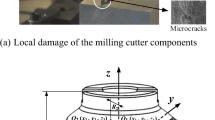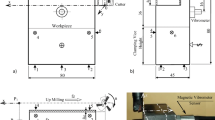Abstract
Due to high cutting speed and intermittent impact load, there exists significant friction and cutting vibration in milling process, which would lead to the mesoscopic friction damages. The friction damages and wear state thus become difficult to predict. In this work, the variation of instantaneous mechanical behavior of the milling cutter flank under vibration was studied. The structural deformation and friction damages of milling cutter flank in macro/mesoscopes were analyzed by conducting both thermal stress coupling field and molecular dynamic analysis. The multi-scale characterization method of instantaneous friction damage on cutter flank was proposed. The super-cell model of the tool-workpiece on the tool flank was developed. The variation of super-cell configuration was obtained. The nucleation and propagation of friction damages were identified; the evolution of mesoscopic friction damages on tool flank were revealed. The mesoscopic friction damage evolution of different positions on tool flank was researched; the coupling and competition mechanisms between the nucleation and propagation process of friction damages were unveiled. The cross-scale identification method of the friction damages of tool flank was validated by experiments.








































Similar content being viewed by others
Data availability
The datasets generated during and/or analyzed during the current study are available from the corresponding author on reasonable request.
References
Cheng YN, Ma CJ, Zhang JY et al (2022) Simulation and experimental study of tool wear in high-speed dry gear hobbing. Int J Adv Manuf Technol 119(5):3181–3204. https://doi.org/10.1007/s00170-021-08421-4
Liang J, Gao H, Xiang S et al (2022) Research on tool wear morphology and mechanism during turning nickel-based alloy GH4169 with PVD-TiAlN coated carbide tool. Wear. 508:204468. https://doi.org/10.1016/j.wear.2022.204468
Chen P, Tong JL, Zhao JH et al (2020) A study of the surface microstructure and tool wear of titanium alloys after ultrasonic longitudinal-torsional milling. J Manuf Process 53:1–11. https://doi.org/10.1016/j.jmapro.2020.01.040
Wang WC, Li JX, Ge Y et al (2021) Structural characteristics and high-temperature tribological behaviors of laser cladded NiCoCrAlY–B4C composite coatings on Ti6Al4V alloy. Trans Nonferrous Met Soc China 31(9):2729–2739. https://doi.org/10.1016/S1003-6326(21)65688-1
Ma J, Li YF, Zhang DH et al (2022) Investigation of tool flank wear effect on system stability prediction in the milling of Ti-6AI-4 V thin-walled workpiece. Int J Adv Manuf Technol 122(9/10):3937–3956. https://doi.org/10.1007/s00170-022-10136-z
Wang ZY, Liang YD, Li HY et al (2022) Milling force and tool wear mechanisms on milling TC21 titanium alloy under different lubrication conditions. Int J Adv Manuf Technol 123(1-2):169–185. https://doi.org/10.1007/s00170-022-10108-3
Yıldırım ÇV, Kıvak T, Sarıkaya M et al (2020) Evaluation of tool wear, surface roughness/topography and chip morphology when machining of Ni-based alloy 625 under MQL, cryogenic cooling and CryoMQL. J Mater Res Technol-JMRT 9(2):2079–2092. https://doi.org/10.1016/j.jmrt.2019.12.069
Li JB, Lu J, Chen CY et al (2021) Tool wear state prediction based on feature-based transfer learning. Int J Adv Manuf Technol 113:3283–3301. https://doi.org/10.1007/s00170-021-06780-6
Khanna N, Agrawal C, Gupta MK et al (2020) Tool wear and hole quality evaluation in cryogenic Drilling of Inconel 718 superalloy. Tribol Int 143:106084. https://doi.org/10.1016/j.triboint.2019.106084
Kumar S, Maity SR, Patnaik L (2021) Effect of tribological process parameters on the wear and frictional behaviour of Cr-(CrN/TiN) composite coating: an experimental and analytical study. Ceram Int 47(11):16018–16028. https://doi.org/10.1016/j.ceramint.2021.02.176
Medabalimi SR, Ramesh MR, Kadoli R (2019) High-temperature wear and frictional behavior of partially oxidized Al with NiCr composite coating. Mater Res Express 6(12):126599. https://doi.org/10.1088/2053-1591/ab5c34
Shah P, Khanna N, Singla AK et al (2021) Tool wear, hole quality, power consumption and chip morphology analysis for drilling Ti-6Al-4V using LN2 and LCO2. Tribol Int 2021(163):107190. https://doi.org/10.1016/j.triboint.2021.107190
Zhao LX, Zhang BL, Liu Y et al (2022) Research progress in improving tribological properties based on surface texture technology. Tribology 42(01):202–224. https://doi.org/10.16078/j.tribology.2020263
Zhou JL, Kong DJ (2021) Friction–wear performances and oxidation behaviors of Ti3AlC2 reinforced Co–based alloy coatings by laser cladding. Surf Coat Technol 408:126816. https://doi.org/10.1016/j.surfcoat.2020.126816
Han L, Cao ZL, Huang Z et al (2021) First-principles calculations of lattice phase transition and thermodynamic properties of A15-type Nb _ (3) Al. Acta Phys Temp Humilis Sin 43(5):7. https://doi.org/10.13380/j.ltpl.2021.05.002
Prasai K, Bassiri R, Cheng HP et al (2021) Annealing-induced changes in the atomic structure of amorphous silica, germania, and tantala using accelerated molecular dynamics. Phys Status Solidi B-Basic Res 258(9):2000519. https://doi.org/10.1002/pssb.202000519
Dai JB, Su HH, Wang ZB et al (2022) Study on the formation mechanism of grinding crack damage of polycrystalline silicon carbide ceramics. Chin J Mech Eng 58(13):307–320. https://doi.org/10.3901/JME.2022.13.307
Sharma A, Datta D, Balasubramaniam R (2021) Prediction of tool wear constants for diamond turn machining of CuBe. J Micro Nanomanuf 4(1):18–26. https://doi.org/10.1177/2516598420930992
Grützmacher P, Gachot C, Eder SJ (2020) Visualization of microstructural mechanisms in nanocrystalline ferrite during grinding. Mater Des 195:109053. https://doi.org/10.1016/j.matdes.2020.109053
Papanikolaou M, Salonitis K (2021) Grain size effects on nanocutting behaviour modelling based on molecular dynamics simulations. Appl Surf Sci 540:148291. https://doi.org/10.1016/j.apsusc.2020.148291
Dong WL, Yang XF, Song F et al (2022) Anti-friction and wear resistance analysis of cemented carbide coatings. Int J Adv Manuf Technol 122(7-8):2795–2821. https://doi.org/10.1007/s00170-022-10092-8
Schneider Y, Weber U, Xu C et al (2022) Experimental and numerical investigations of micro-meso damage evolution for a WC/Co-type tool material. Materialia 21:101343. https://doi.org/10.2139/ssrn.3910610
Funding
This research was funded by the Natural Science Foundation of Heilongjiang Province of China, ZD2020E008; the National Natural Science Foundation of China, 52105440; and the National Natural Science Foundation of China, 51875145; Opening Project of the Key Laboratory of Advanced Processing Technology and Intelligent Manufacturing (Heilongjiang Province), KFKT202206.
Author information
Authors and Affiliations
Contributions
All authors contributed to the study conception and design. Conceptualization, Bin Jiang and Feifei Li; methodology, Peiyi Zhao and Bin Jiang; software, Feifei Li and Lili Fan; validation, Shuling Sun and Feifei Li; investigation, Lili Fan and Shuling Sun; data curation, Shuling Sun and Feifei Li; writing—original draft preparation, Feifei Li; writing—review and editing, Feifei Li and Peiyi Zhao; supervision, Bin Jiang and Peiyi Zhao; project administration, Bin Jiang and Peiyi Zhao; funding acquisition, Bin Jiang and Peiyi Zhao. All authors commented on previous versions of the manuscript. All authors read and approved the final manuscript.
Corresponding author
Ethics declarations
Ethics approval and consent to participate
This chapter does not contain any studies with human participants or animals performed by any of the authors.
Consent for publication
All authors consent to the publications of the manuscript in this journal.
Conflict of interest
The authors declare no competing interests.
Additional information
Publisher’s Note
Springer Nature remains neutral with regard to jurisdictional claims in published maps and institutional affiliations.
Rights and permissions
Springer Nature or its licensor (e.g. a society or other partner) holds exclusive rights to this article under a publishing agreement with the author(s) or other rightsholder(s); author self-archiving of the accepted manuscript version of this article is solely governed by the terms of such publishing agreement and applicable law.
About this article
Cite this article
Jiang, B., Li, F., Zhao, P. et al. Cross-scale identification method for friction damage on the tool flank of high-feed milling cutter. Int J Adv Manuf Technol 131, 3665–3694 (2024). https://doi.org/10.1007/s00170-024-13122-9
Received:
Accepted:
Published:
Issue Date:
DOI: https://doi.org/10.1007/s00170-024-13122-9




